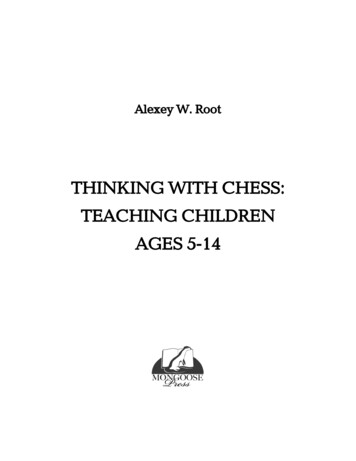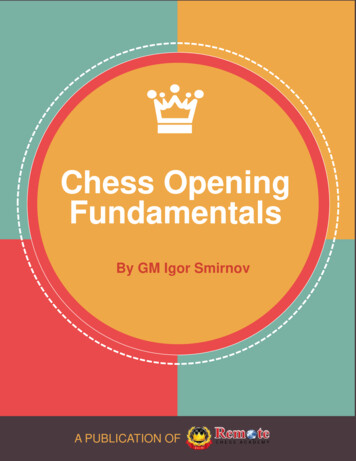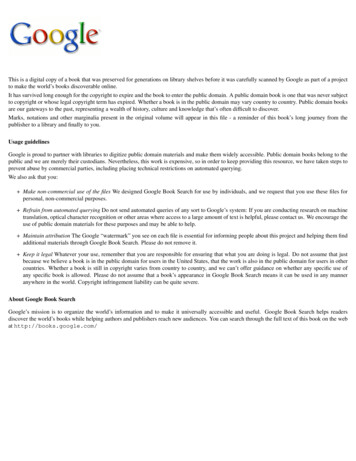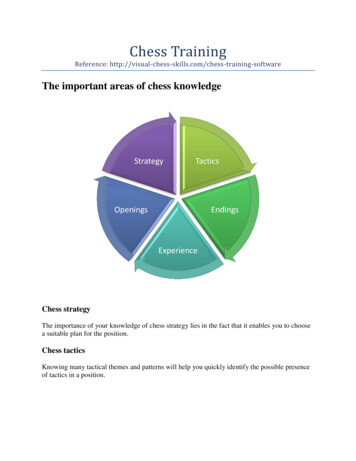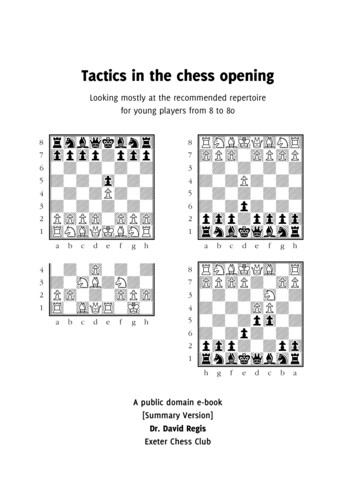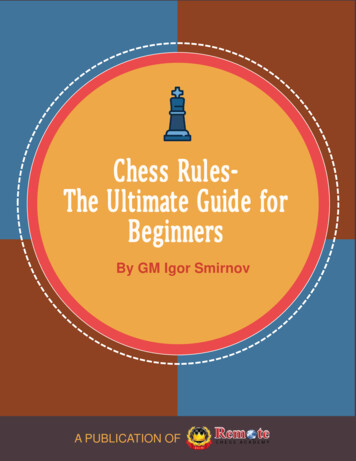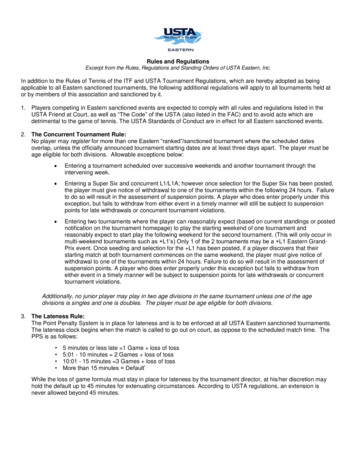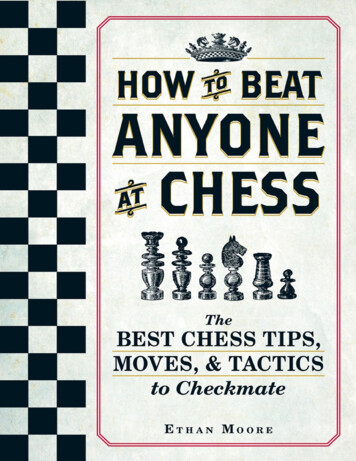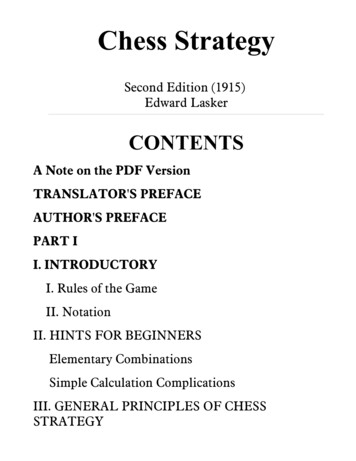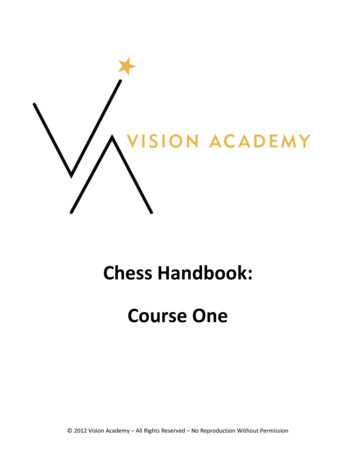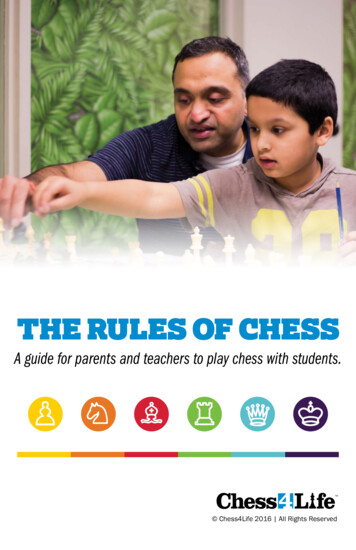
Transcription
THE RULES OF CHESSA guide for parents and teachers to play chess with students.TM Chess4Life 2016 All Rights Reserved
Table of ContentsThe BasicsTopic 1: The Game . 3Topic 2: The Board . 3Topic 3: The Pieces . 4Topic 4: The King . 5Topic 5: The Rook . 6Topic 6: The Bishop . 7Topic 7: The Queen . 8Topic 8: The Knight . 9Topic 9: The Pawns . 10Special Rules & Ending a GameTopic 10: Pawn Promotion . 11Topic 11: Checkmate . 12Topic 12: Castling . 13Topic 13: En Passant . 14Topic 14: Draws . 15NOTE: Click here or on any of the topic headers to viewthe "Rules of Chess" video series.Copyright 2016 by Chess4Life LLC.All rights reserved. No part of this publication may be reproduced, distributed, or transmitted inany form or by any means, including photocopying, recording, or other electronic or mechanicalmethods, without the prior written permission of the publisher. For more information on how toTMliscence this or other Chess4Life material, please contact us at kids@chess4life.com.
Topic 1: The GameChess is a game for two players. Oneplayer controls the white pieces and theother player controls the black pieces.Traditionally, players start the game byshaking hands with their opponent. Whitealways moves first and then players taketurns (white then black then white, etc). Turns consist of moving apiece from one square to another square (as described in topics 4 - 9).A player may capture an opponent’s piece by moving their piece tothe square the opponent’s piece occupies, in doing so, removing theopponent’s piece and setting it on the side of the board. A player maynever capture their own piece. The goal of the game is to checkmatean opponent's King (as explained in Topic 11).Topic 2: The BoardThe chess board is a checkeredboard made up of eight verticalcolumns, called files, and eighthorizontal rows, called ranks. Thiscreates 64 squares, both light anddark. Every rank and file has a name.The a - file, b - file, c - file, etc. The1st rank, 2nd rank, etc. This givesevery square a name listed by letterand number (eg. b3, d7, g5, h1) Ref:[Figure 2.1]. The chessboard must be setup so that both players have a whitesquare on their right hand corner.8d776g554b332h11ABCDEFGHFigure 2.1CLICK HERE TO VIEW THE "RULES OF CHESS" VIDEO SERIESTMChess4Life LLC. Copyright 2016
Topic 3: The PiecesThere are six different types of chesspieces: King, Queen, Rook, Bishop,Knight, and Pawn. The chess setcontains pieces of two differentcolors, one light and one dark, calledWhite and Black. The board is setup as shown [Ref: Figure 3.1]. The whitepieces begin on the 1st and 2nd ranksand the black pieces begin on the7th and 8th ranks. The white Queenbegins on a light square and theblack queen begins on a dark square.87654321ABCDEFGHFigure 3.1Each piece has a relative point value based on its mobility.Understanding these point values allows a player to evaluate whetherexchanging pieces is a good or bad idea; however, point values haveno direct impact on the result of a game. See topic 11 for how to wina chess game.FUN ACTIVITY:Ready, SETUP, Go!: Start with all pieces piled inthe middle of your chess board. Time yourselfto see how quickly you can correctly setup allthe pieces in their starting positions! Can youdo it in less than 30 seconds?Bonus: The Chess4Life team was able tosetup the board in less than 14 seconds. Canyou beat our time?87654321ABCDEFGHCLICK HERE TO VIEW THE "RULES OF CHESS" VIDEO SERIESTMChess4Life LLC. Copyright 2016
Topic 4: The KingSince the object of the game is to checkmate the King, it is the mostimportant piece in the game of chess. The King moves one squarein any direction. The King captures in the same way that it moves(moving the King one square to the square that the opponent’s piecesoccupies and then removing the opponent’s piece) [Ref: Figures 4.1 & 4.2].The King may never move into or through danger and the King maynever be removed from the board. If a player makes a move thatleaves or puts their King in danger, this is an illegal move. It must betaken back and a legal move must be played. The white King beginsthe game on e1 and the black King begins the game on e8.8877665544332211ABCDEFGHABCDEFGFigure 4.1HFigure 4.2FUN ACTIVITY:Capture the Pawns - King: Set up your chessboard as shown to the right and see if you canuse the King to capture all of the pawns in theleast number of moves possible.BONUS: Great job! For an extra challenge,repeat the previous exercise but this time makesure that your King never steps into danger.Can you find a way to accomplish this in just18 moves? Note: This requires an understandingof topic 9.87654321ABCDEFGHActivity 4.1TMChess4Life LLC. Copyright 2016
Topic 5: The RookThe Rook (sometimes incorrectly called a castle) moves up, down,left, or right, 1 - 7 squares in any direction until the Rook reaches anobstruction or captures a piece (the Rook cannot jump over pieces andcan only capture one piece per turn) [Ref: Figures 5.1 & 5.2]. The white Rooksbegin the game in the corners, a1 and h1. The black Rooks begin in thecorners, a8 and h8. The Rook has a piece value of 5 points.8877665544332211ABCDEFGHABCDEFGFigure 5.1HFigure 5.2FUN ACTIVITY:Capture the Pawns - Rook: Set up your chessboard as shown to the right and see if you canuse the Rook to capture all of the pawns in theleast number of moves possible.8BONUS: Awesome! Now that you’ve figured outhow to capture all of the pawns, try again, butthis time make sure that the Rook never movesinto danger. Can you find a way to accomplishthis in just 12 moves? Note: This requires an4understanding of topic 9.765321ABCDEFGHActivity 5.1CLICK HERE TO VIEW THE "RULES OF CHESS" VIDEO SERIESTMChess4Life LLC. Copyright 2016
Topic 6: The BishopThe Bishop only moves diagonally. The Bishop may move 1-7 squaresin any diagonal direction [Ref: Figure 6.1]. The Bishop cannot jump overpieces and can only capture one piece per turn [Ref: Figure 6.2]. Becausethe Bishop moves diagonally, it may never move to a different colorother than the one it starts on. Each player has a light-squared Bishopand a dark-squared Bishop. The white Bishops begin on c1 and f1.The black Bishops begin on c8 and f8. The Bishop has a piece valueof 3 points.8877665544332211ABCDEFGHABCDEFGHFigure 6.2Figure 6.1FUN ACTIVITY:8Capture the Pawns - Bishop: Set up yourchess board as shown to the right and see ifyou can use the Bishop to capture all of thepawns in the least number of moves possible.BONUS: Good job! For an extra challenge,repeat the previous exercise but this time makesure that your Bishop never steps into danger.Can you find a way to accomplish this in just11 moves? Note: This requires an understandingof topic 9.7654321ABCDEFGHActivity 6.1CLICK HERE TO VIEW THE "RULES OF CHESS" VIDEO SERIESTMChess4Life LLC. Copyright 2016
Topic 7: The QueenThe Queen is the most powerful piece in the game of chess. TheQueen can move 1-7 squares in any direction, up, down, left, right, ordiagonal, until the Queen reaches an obstruction or captures a piece;however, the Queen cannot jump over pieces and can only captureone piece per turn [Ref: Figure 7.1 & 7.2]. The white Queen begins the gameon d1 and the black Queen on d8. The Queen has a piece value of 9points.8877665544332211ABCDEFGHABCDEFGFigure 7.1HFigure 7.2FUN ACTIVITY:Capture the Pawns - Queen: Set up your chessboard as shown to the right and see if you canuse the Queen to capture all of the pawns inthe least number of moves possible.8BONUS: Fantastic! For an extra challenge,repeat the previous exercise but this time makesure that your Queen never steps into danger.Can you find a way to accomplish this in just 8moves? Note: This requires an understanding of4topic 9.765321ABCDEFGHActivity 7.1CLICK HERE TO VIEW THE "RULES OF CHESS" VIDEO SERIESTMChess4Life LLC. Copyright 2016
Topic 8: The KnightThe Knight moves in a direction described as an “L”. The Knight, froma starting square, moves 2 squares, up, down, left, or right, and thenone square at a right angle, forming an “L” [Ref: Figure 8.1 & 8.2]. The Knightis the only piece that may jump over other pieces but only captures thepiece of the square that he lands on (not the pieces he jumps over).The white Knights begin the game on b1 and g1. The black Knightsbegin on b8 and g8. The Knight has a piece value of 3 points (equalto the Bishop). NOTE: EVERY move the Knight makes ALWAYS changes the colorof the square that it stands on.8877665544332211ABCDEFGHABCDEFGFigure 8.1HFigure 8.2FUN ACTIVITY:Capture the Pawns - Knight: Set up your chessboard as shown to the right and see if you canuse the Knight to capture all of the pawns inthe least number of moves possible.BONUS: Wonderful! For an extra challenge,repeat the previous exercise, but this timemake sure that your Knight never steps intodanger. Can you find a way to accomplishthis in just 18 moves? Note: This requires anunderstanding of topic 9.87654321ABCDEFGHActivity 8.1TMChess4Life LLC. Copyright 2016
Topic 9: The PawnsThe Pawn moves directly forward [Ref: Figure 9.1], never backward or tothe side. Pawns move exactly one square forward; though each Pawnmay advance two squares forward the first time it is moved. Pawnscapture a piece that is one square diagonally forward [Ref: Figure 9.2].Though Pawns normally cannot move diagonally, this is the only waythey capture. Pawns are the only piece that capture differently thanthey move. The white Pawns begin on the 2nd rank and the blackPawns begin on the 7th rank. The Pawn has a piece value of 1 point.8877665544332211ABCDEFGAHBCDEFFUN ACTIVITY:GHFigure 9.2Figure 9.187Pawn Game: Set up the chessboard like the diagram to theright. With a partner, play agame of chess using only Pawnson the board. The first personto get one of their Pawns to theother side of the board is thewinner!654321ABCDEFGHActivity 9.1CLICK HERE TO VIEW THE "RULES OF CHESS" VIDEO SERIESTMChess4Life LLC. Copyright 2016
Topic 10: Pawn PromotionPawns are the only piece in chess that may promote. Promotionoccurs when the Pawn reaches the opposite side of the board (1st rankfor black, 8th rank for white). In the same turn, the Pawn is removedfrom the board and is replaced with an extra piece of the promotingplayer’s choice [Ref: Figure 10.1 & 10.2], (Queen, Rook, Bishop, or Knight)even if these pieces are already on the board. This concludes theplayer’s turn.8877665544332211ABCDEFGHABCDEFFigure 10.1FUN ACTIVITY:GHFigure 10.287Pawn Game - Part 2: Set up the chess boardlike the diagram to the right. With a partner,play a game of chess with only Pawns andkings on the board. The goal of this game isto get one of your Pawns to the other side ofthe board and promote it! The winner is thefirst person to promote a Pawn and captureall of their opponent's Pawns.654321ABCDEFGHActivity 10.1CLICK HERE TO VIEW THE "RULES OF CHESS" VIDEO SERIESTMChess4Life LLC. Copyright 2016
Topic 11: CheckmateCheckmate immediately ends the game (the King is never removedfrom the board) and players shakehands to agree. Checkmate is8the goal of the game of chess.7Checkmate is when one player6puts the opponent’s King in danger5(called “check”) and the opponentcan do nothing with their King or4any other pieces to stop the King3from being in danger [Ref: Figure 11.1 &211.2] (run away with the King, capture1the checking piece, or use anotherABCDEFGHpiece to block.) [Ref: Figure 11.3]Figure 11.18877665544332211ABCDEFGHABCDEFGHFigure 11.3Figure 11.2FUN ACTIVITY:Make-a-Mate: Using the pieces designated as “You have,” set the pieces onthe board so that the “Defending” King is in Checkmate.1234You HaveDefender(e8)TMChess4Life LLC. Copyright 2016
Topic 12: CastlingCastling is a special move to make the King safer. In one turn, theKing moves two squares towards one Rook and that Rook jumps overthe King, landing next to the King. [Ref: Figure 13.1 &13.2]Rules for Castling:1. The King cannot castle if either the King or the Rookinvolved have already moved in that game.2. There can be no pieces between the King and the Rook.3. The King cannot castle while in check. [Ref: Figure 13.3]4. The King cannot castle into or through check. [Ref: Figure 13.4]5. The King can never gure 13.2Figure 13.1CANNOT CASTLECANNOT CASTLE8877665544332211ABCDEFGHFigure 13.3ABCDEFGHFigure 13.4TMChess4Life LLC. Copyright 2016
Topic 13: En PassantEn Passant is a special Pawn move. If a Pawn steps forward twosquares, landing adjacent to an opponent’s Pawn, the opponent’sPawn may capture as though it moved only one square. The EnPassant capture may only take place after a Pawn moves two squaresand only on the move immediately following. [Ref: Figures 12.1 & 12.2]8877665544332211ABCDEFGHABCDEFFigure 12.1FUN ACTIVITY:GHFigure 12.287En Passant Challenge: Set up the chessboard like the diagram to the right. Witha partner, play a game of chess using onlyPawns on the board. This is a cooperativegame where the goal is to work with yourpartner to see how many En Passantcaptures you can do in one
There are six different types of chess pieces: King, Queen, Rook, Bishop, Knight, and Pawn. The chess set contains pieces of two different colors, one light and one dark, called White and Black. The board is set up as shown [Ref: Figure 3.1]. The white pieces begin on the 1st and 2nd ranks and the black pieces begin on the 7th and 8th ranks .
